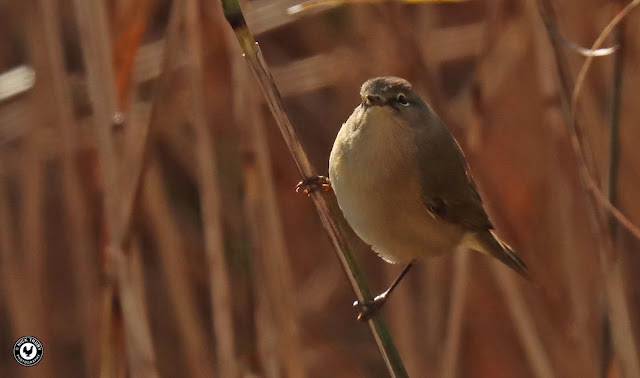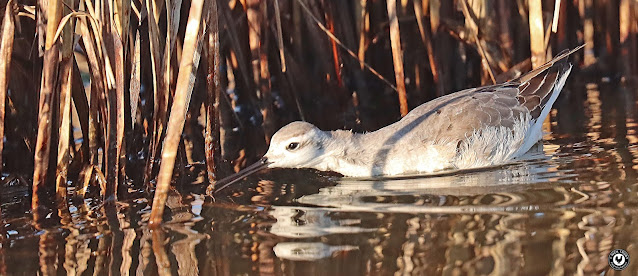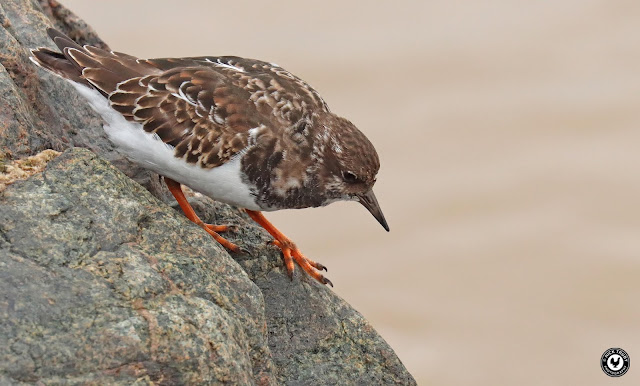While we toiled away in Southwold the previous day looking for the elusive Radde's warbler, I made regular checks, as I always do, of the bird news services. A report of a rare wading bird from North America, seen on the South coast, made me rather rue my decision to head out East even though the Radde's Warbler was a life tick and I had seen the species of wader in question before. Photos of the bird began filtering onto social media and revealed that people were getting point blank views of the bird. We would just have to get up early on the Sunday morning and go to see it for ourselves.
We had seen a Wilson's Phalarope once before, a breeding plumaged male that had incredibly pitched up at a recently excavated lagoon at Hillesden near Buckingham, and at just ten miles from our home is one of the rarest birds that we've seen locally. Wilson's Phalaropes breed in North-west America and Canada so that individual on the 27th and 28th May in 2006 was way off course. Two weeks ago a Wilson's Phalarope had been found at the WWT reserve of Martin Mere in Lancashire and we had made plans to go and see that but, after staying for a few days, it predictably disappeared just before the weekend. The bird then found at Pennington Marshes in Hampshire a week later was probably the same bird relocating southwards.
An early start was required. I had never visited Pennington Marshes before but research had shown that the parking area closest to the Fishtail Lagoon, where the Wilson's Phalarope was residing, was very small and I wanted to be sure of grabbing a space. My decision to get there as soon as we could, proved worthwhile as I just about managed to wedge my car into the last tiny space. At seven-thirty the narrow access lane and carpark were already busy, we were definitely not the only folk wanting to see the Phalarope.
We made our way across a grassy field towards the sea wall and could see a lot of other birders in the distance. There was an added bonus to twitching the Wilson's Phalarope too, in the form of two Grey Phalaropes that were also on site and we came to them first. The Grey Phalaropes were feeding in a cutting that ran alongside the lagoon. As per usual they were incredibly obliging and were giving superb close views as they dynamically worked their way up and down the stream. This morning was beautiful too, warm sunshine bathed us in bright clear light, even I should be capable of taking some decent photos in such conditions, mmm maybe not! Double checking that my camera had a battery installed, after my cock-up of the previous morning, I took a few initial record shots and then settled down to take a few more.
 |
| Grey Phalaropes |
The Grey Phalaropes weren't gaining much attention since most birders and toggers were stationed further along the sea wall where the Wilson's Phalarope must be. I had a quick look at the watchers, some were stood up on the embankment overlooking the lagoon, others were stood on a track right next to the reedy edge of the water. None were watching anything but instead were chatting amongst themselves and comparing back of the camera photos. I deduced therefore that the Wilson's Phalarope was currently off view, it was probably hidden in the thickly vegetated strip next to the track, so played it cool and spent another ten minutes to watch and photograph the two clockwork toy-like Grey Phalaropes.
Grey Phalaropes as they are called, are actually correctly named as Red Phalaropes because when in breeding plumage they are decked in brick-red colours. I've never seen a breeding plumaged Red Phalarope, birds in such condition are rare in the UK, and so know them as Grey Phalaropes. We've seen many before, including one at our local Bicester Wetland Reserve a couple of years ago, but never tire of watching them. Last year when compiling our "big year list" we had to travel down to Stanpit Marsh in Dorset to get our Grey Phalarope fix since none turned up locally at all (read here). The two that we watched now ratcheted our year list for 2020 up to 224, last year the Stanpit Marsh bird made it 268, a testimony to the difficulties imposed by the lockdown travelling restrictions of earlier and our lack of any birding holidays this year. At least with yesterdays birds in Suffolk and these Phalaropes today, we were still adding birds in spite of missing out on our fortnight in Cornwall.
We joined the throng alongside the Fishtail Lagoon, presumably so named because of its shape, waiting for the reappearance of the Wilson's Phalarope. A chap told me that it was indeed concealed within the dense reeds but had, amazingly, been showing right at the edge of the water and views were from just a few feet. All Phalarope species seem to be unwary and not at all frightened by people, because they breed in the Arctic I suppose they've never encountered any humans before so haven't learned to mistrust us. They may have already learned though that the Sparrowhawk that bombed past spelt danger and perhaps that was why it had decided to take cover for a while.
 |
| Sparrowhawk |
Ten minutes later a birder stood a short way to our left indicated that the Wilson's Phalarope had emerged and was feeding in the relatively open channels again. This started a mini-stampede of over zealous birders and toggers all desperate to get their photos. Social distancing, whether agreed with or not, was forgotten about in the haste and quest to take the closest and best vantage points. Mrs Caley very wisely remained away from the gaggle and watched the bird through her bins. I naturally wanted my photos too but thought it better to walk past the unruly rabble and wait further along the lagoon for the Phalarope to reach me. I did take a few initial images as I passed though, and the bird was so close they could hardly be deemed record shots!
 |
| Wilson's Phalarope |
I had selected a more open tract of water to wait by and sure enough the Wilson's Phalarope duly meandered into it. Now I had prime position and, trying my best to ignore the others that were gathering around me, I rattled off frame after frame. Unfortunately as my results would prove later, despite realising that the Phalarope's very bright white and grey plumage would blow out the exposure, I failed to reduce the camera's exposure by enough stops so too many of my photos were sub-standard. Eventually, hopefully, I'll get my act together and I recalled that memorable quote by the great guitarist BB King who when asked 'why did he practice so much?', replied "because one day I'll get it right". We'll see.
The Wilson's Phalarope was feeding voraciously, nimbly picking small insects, of which there seemed to be many, from the weedy stems. To that aim the bird would stretch forward and secure its food with the very tip of its long bill before deftly dispatching the victim. I moved again, along the bank a bit more to the next open spot of water since the Phalarope was slowly drifting that way.
For a few brief moments I had the Wilson's Phalarope all to myself as it swam out into the open area in front of me. Most of the other birders/toggers were too busy looking at the incredible shots that they'd already taken. I took advantage of the temporary lull in activity by kneeling down and thus getting closer to the water surface. I was treated to the most extraordinary close views of the swimming bird. It was bliss, until somebody, part of the new scrum that had formed behind me, trod on my foot. That was enough for me, I just didn't want to be part of the almost hysterical behaviour taking place amongst some of the folk who had just arrived. As I walked away I felt sorry for the bird and also a little bit guilty that I had been part of the harassment that it was having to endure, even though I was sure to always give the Phalarope space and let the bird come to me. To be fair the bird didn't appear to be bothered by the attention that it was getting but the poor behaviour of a few was irritating and I found it embarrassing.
I was further irritated when I reviewed my photos at home later in the day and realised my error in not adjusting the exposure enough. I had captured some images of the Phalarope snaring insects and they would have been brilliant, apart from the fact that they were completely ruined by over exposure. The latest blunder in a long series of photography mishaps recently.
I had spent less than twenty minutes in the company of the Wilson's Phalarope. I was glad though to get away from the crowds and take respite. Twitching is becoming more frenetic with most folk present wanting to gain photos and not, it seems, always caring for the subject or for anyone else that is there. It's a really big problem when the target bird is giving close up views. That may be an over statement of the real situation but that's how it appears to me. Now that Mrs Caley and I were on our own we took time to look at some of the other birds that were on the reserve. We found a Grey Plover, on the salt marsh, new for the year and number 226 on that list. A female Goosander was in the channel just offshore. The Lagoon had Pintail, Shoveler and Teal.
 |
| Grey Plover |
 |
| Goosander |
 |
| Pintail & Wigeon |
We were back with one of the Grey Phalarope's again and I couldn't resist taking more images. We sat at the end of the channel and waited for the bird to swim towards us. This time there was no madness taking place around me and I happily "filled my boots".
When the Grey Phalarope swam away back down the channel we moved as if to leave but then I just had to stop and take even more photos. The Wilson's Phalarope was definitely the star bird of the day but for my money the Grey Phalaropes are nicer and I could happily have stayed all day with them. They are such captivating and attractive little birds and their hyperactive manner make them most endearing and enjoyable to watch.
A smart juvenile Oystercatcher had been probing for food on the bank between the channel and the lagoon all morning so I thought it would be rude not to gain a photo or two. We consider Oystercatchers to be plain black and white birds but when the sun shines, that body plumage shines a radiant set of browns and glossy purples. Plus there is that big red bill, albeit short and a bit dull on this young bird.
 |
| Oystercatcher |
Of course while watching the Oystercatcher it was impossible not to be distracted by the Grey Phalarope once more. The persistent tugging on my sleeve was my wife's final resort, and demand, to get me to leave!
We walked back the long way around the field which I know by my research holds Dartford Warblers in the scattered gorse bushes. We didn't see any on this occasion but did spot a number of Chiffchaffs at the reedy edge of the sea wall and a small group of Bearded Tits fluttered past. Cetti's warblers exploded into song in many places We will certainly have to visit this exciting reserve again, probably in the spring when it should be alive with recently returned migrant breeders as well as those special resident species.
 |
| Chiffchaff |
The worst part of the day was trying to extricate ourselves and our car from the carpark and the narrow lane. Birders, as well as locals out to walk the dog or just exercising, were arriving all the time and parking had become problematic. I had to back up into passing places as much as I could drive forwards to allow other drivers to pass and the whole access road was getting close to gridlock because of ill judged parking on bends and in some of the passing spots. I dreaded the mess that must have been building up at the actual carpark itself where there were no spaces to either park or turn around in. The Wilson's Phalarope had certainly aroused a lot of interest. When I finally emerged back into the village, I was a relieved man.
Our weekend birding had been a terrific one, with a confirmed lifer in the Southwold Radde's Warbler, just our second record of the fabulous Wilson's Phalarope plus fantastic views of other wading birds such as Purple Sandpiper, Turnstone and Grey phalarope. Definitely well worth leaving home for.












































































